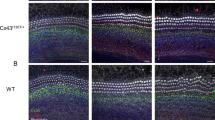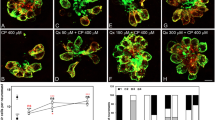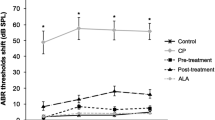Abstract
Cis-diamminedichloroplatinum (cisplatin) is an effective chemotherapeutic drug for cancer therapy. However, most patients treated with cisplatin are at a high risk of ototoxicity, which causes severe hearing loss. Inspired by the “Good Samaritan effect” or “bystander effect” from gap junction coupling, we investigated the role of gap junctions in cisplatin-induced ototoxicity as a potential therapeutic method. We showed that connexin 43 (Cx43) was highly expressed in House Ear Institute-Organ of Corti 1 (HEI-OC1) cells, mediating cell–cell communication. The viability of HEI-OC1 cells was greatly decreased by cisplatin treatment, and cisplatin-treated HEI-OC1 cells showed lower Cx43 expression compared to that of untreated HEI-OC1 cells. In particular, high accumulation of Cx43 was observed around the nucleus of cisplatin-treated cells, whereas scattered punctuate expression of Cx43 was observed in the cytoplasm and membrane in normal cells, suggesting that cisplatin may interrupt the normal gap junction communication by inhibiting the trafficking of Cx43 to cell membranes in HEI-OC1 cells. Interestingly, we found that the inhibition of gap junction activity reduced cisplatin-induced apoptosis of auditory hair cells. Cx43 siRNA- or 18α-GA-treated HEI-OC1 cells showed higher cell viability compared to control HEI-OC1 cells during cisplatin treatment; this was also supported by fluorescence recovery after photobleaching studies. Inhibition of gap junction activity reduced recovery of calcein acetoxymethyl ester fluorescence compared to control cells. Additionally, analysis of the mechanisms involved demonstrated that highly activate extracellular signal-regulated kinase and protein kinase B, combined with inhibition of gap junctions may promote cell viability during cisplatin treatment.





Similar content being viewed by others
Abbreviations
- 18α-GA:
-
18 alpha-glycyrrhetinic acid
- Akt:
-
Protein kinase B
- ATP:
-
Adenosine triphosphate
- cAMP:
-
Cyclic adenosine monophosphate
- cGMP:
-
Cyclic guanosine monophosphate
- Cisplatin:
-
Cis-diamminedichloroplatinum
- Cx:
-
Connexin
- ERK:
-
Extracellular signal-regulated kinase
- FRAP:
-
Fluorescence recovery after photobleaching
- HEI-OC1:
-
House Ear Institute-Organ of Corti 1
- InsP3:
-
Inositol trisphosphate
- MAPK:
-
Mitogen-activated protein kinases
- NOX3:
-
NADPH oxidase 3
- PKC:
-
Protein kinase C
- ROS:
-
Reactive oxygen species
- SLDT:
-
Scrape load dye transfer
References
Rybak LP, Whitworth CA, Mukherjea D, Ramkumar V (2007) Mechanisms of cisplatin-induced ototoxicity and prevention. Hear Res 226:157–167
Rybak LP, Mukherjea D, Jajoo S, Ramkumar V (2009) Cisplatin ototoxicity and protection: clinical and experimental studies. Tohoku J Exp Med 219:177–186
McKeage MJ (1995) Comparative adverse effect profiles of platinum drugs. Drug Saf 13:228–244
Campbell KC, Meech RP, Rybak LP, Hughes LF (1999) d-Methionine protects against cisplatin damage to the stria vascularis. Hear Res 138:13–28
Li G, Liu W, Frenz D (2006) Cisplatin ototoxicity to the rat inner ear: a role for HMG1 and iNOS. Neurotoxicology 27:22–30
More SS, Akil O, Ianculescu AG, Geier EG, Lustig LR, Giacomini KM (2010) Role of the copper transporter, CTR1, in platinum-induced ototoxicity. J Neurosci 30:9500–9509
Ciarimboli G, Deuster D, Knief A, Sperling M, Holtkamp M, Edemir B, Pavenstadt H, Lanvers-Kaminsky C, am Zehnhoff-Dinnesen A, Schinkel AH, Koepsell H, Jurgens H, Schlatter E (2010) Organic cation transporter 2 mediates cisplatin-induced oto- and nephrotoxicity and is a target for protective interventions. Am J Pathol 176:1169–1180
Banfi B, Malgrange B, Knisz J, Steger K, Dubois-Dauphin M, Krause KH (2004) NOX3, a superoxide-generating NADPH oxidase of the inner ear. J Biol Chem 279:46065–46072
Mukherjea D, Jajoo S, Kaur T, Sheehan KE, Ramkumar V, Rybak LP (2010) Transtympanic administration of short interfering (si)RNA for the NOX3 isoform of NADPH oxidase protects against cisplatin-induced hearing loss in the rat. Antioxid Redox Signal 13:589–598
Lee JS, Kang SU, Hwang HS, Pyun JH, Choung YH, Kim CH (2010) Epicatechin protects the auditory organ by attenuating cisplatin-induced ototoxicity through inhibition of ERK. Toxicol Lett 199:308–316
Mukherjea D, Rybak LP (2011) Pharmacogenomics of cisplatin-induced ototoxicity. Pharmacogenomics 12:1039–1050
Devarajan P, Savoca M, Castaneda MP, Park MS, Esteban-Cruciani N, Kalinec G, Kalinec F (2002) Cisplatin-induced apoptosis in auditory cells: role of death receptor and mitochondrial pathways. Hear Res 174:45–54
Saez JC, Berthoud VM, Branes MC, Martinez AD, Beyer EC (2003) Plasma membrane channels formed by connexins: their regulation and functions. Physiol Rev 83:1359–1400
Sohl G, Willecke K (2003) An update on connexin genes and their nomenclature in mouse and man. Cell Commun Adhes 10:173–180
Krutovskikh VA, Piccoli C, Yamasaki H (2002) Gap junction intercellular communication propagates cell death in cancerous cells. Oncogene 21:1989–1999
Garcia-Dorado D, Rodriguez-Sinovas A, Ruiz-Meana M (2004) Gap junction-mediated spread of cell injury and death during myocardial ischemia-reperfusion. Cardiovasc Res 61:386–401
Farahani R, Pina-Benabou MH, Kyrozis A, Siddiq A, Barradas PC, Chiu FC, Cavalcante LA, Lai JC, Stanton PK, Rozental R (2005) Alterations in metabolism and gap junction expression may determine the role of astrocytes as “good Samaritans” or executioners. Glia 50:351–361
Carrio M, Mazo A, Lopez-Iglesias C, Estivill X, Fillat C (2001) Retrovirus-mediated transfer of the herpes simplex virus thymidine kinase and connexin26 genes in pancreatic cells results in variable efficiency on the bystander killing: implications for gene therapy. Int J Cancer 94:81–88
Sun P, Liu Y, Ying H, Li S (2012) Action of db-cAMP on the bystander effect and chemosensitivity through connexin 43 and Bcl-2-mediated pathways in medulloblastoma cells. Oncol Rep 28:969–976
Garcia-Rodriguez L, Perez-Torras S, Carrio M, Cascante A, Garcia-Ribas I, Mazo A, Fillat C (2011) Connexin-26 is a key factor mediating gemcitabine bystander effect. Mol Cancer Ther 10:505–517
Blanc EM, Bruce-Keller AJ, Mattson MP (1998) Astrocytic gap junctional communication decreases neuronal vulnerability to oxidative stress-induced disruption of Ca2+ homeostasis and cell death. J Neurochem 70:958–970
Giaume C, Froger N, Koulakoff A (2005) Gap junction-mediated intercellular communication in astrocytes and neuroprotection. Ann Fr Anesth Reanim 24:695–696
Perez Velazquez JL, Frantseva MV, Naus CC (2003) Gap junctions and neuronal injury: protectants or executioners? Neuroscientist 9:5–9
Ahmad S, Chen S, Sun J, Lin X (2003) Connexins 26 and 30 are co-assembled to form gap junctions in the cochlea of mice. Biochem Biophys Res Commun 307:362–368
Suzuki T, Takamatsu T, Oyamada M (2003) Expression of gap junction protein connexin43 in the adult rat cochlea: comparison with connexin26. J Histochem Cytochem 51:903–912
Zdebik AA, Wangemann P, Jentsch TJ (2009) Potassium ion movement in the inner ear: insights from genetic disease and mouse models. Physiology (Bethesda) 24:307–316
Kikuchi T, Kimura RS, Paul DL, Takasaka T, Adams JC (2000) Gap junction systems in the mammalian cochlea. Brain Res Brain Res Rev 32:163–166
Kikuchi T, Adams JC, Miyabe Y, So E, Kobayashi T (2000) Potassium ion recycling pathway via gap junction systems in the mammalian cochlea and its interruption in hereditary nonsyndromic deafness. Med Electron Microsc 33:51–56
Chang Q, Tang W, Ahmad S, Zhou B, Lin X (2008) Gap junction-mediated intercellular metabolite transfer in the cochlea is compromised in connexin30 null mice. PLoS ONE 3:e4088
Zhao HB, Kikuchi T, Ngezahayo A, White TW (2006) Gap junctions and cochlear homeostasis. J Membr Biol 209:177–186
Gossman DG, Zhao HB (2008) Hemichannel-mediated inositol 1,4,5-trisphosphate (IP3) release in the cochlea: a novel mechanism of IP3 intercellular signaling. Cell Commun Adhes 15:305–315
Zhao HB, Yu N, Fleming CR (2005) Gap junctional hemichannel-mediated ATP release and hearing controls in the inner ear. Proc Natl Acad Sci USA 102:18724–18729
Kudo T, Kure S, Ikeda K, Xia AP, Katori Y, Suzuki M, Kojima K, Ichinohe A, Suzuki Y, Aoki Y, Kobayashi T, Matsubara Y (2003) Transgenic expression of a dominant-negative connexin26 causes degeneration of the organ of Corti and non-syndromic deafness. Hum Mol Genet 12:995–1004
Teubner B, Michel V, Pesch J, Lautermann J, Cohen-Salmon M, Söhl G, Jahnke K, Winterhager E, Herberhold C, Hardelin JP, Petit C, Willecke K (2003) Connexin30 (Gjb6)-deficiency causes severe hearing impairment and lack of endocochlear potential. Hum Mol Genet 12:13–21
Chi SS, Rattner JB, Sciore P, Boorman R, Lo IK (2005) Gap junctions of the medial collateral ligament: structure, distribution, associations and function. J Anat 207:145–154
Decrock E, Vinken M, De Vuyst E, Krysko DV, D’Herde K, Vanhaecke T, Vandenabeele P, Rogiers V, Leybaert L (2009) Connexin-related signaling in cell death: to live or let die? Cell Death Differ 16:524–536
Lampe PD, Kistler J, Hefti A, Bond J, Muller S, Johnson RG, Engel A (1991) In vitro assembly of gap junctions. J Struct Biol 107:281–290
Imanaga I, Hai L, Ogawa K, Matsumura K, Mayama T (2004) Phosphorylation of connexin in functional regulation of the cardiac gap junction. Exp Clin Cardiol 9:161–164
Wada T, Penninger JM (2004) Mitogen-activated protein kinases in apoptosis regulation. Oncogene 23:2838–2849
Patel SJ, Milwid JM, King KR, Bohr S, Iracheta-Velle A, Li M, Vitalo A, Parekkadan B, Jindal R, Yarmush ML (2012) Gap junction inhibition prevents drug-induced liver toxicity and fulminant hepatic failure. Nat Biotechnol 30:179–183
Fillat C, Carrio M, Cascante A, Sangro B (2003) Suicide gene therapy mediated by the Herpes Simplex virus thymidine kinase gene/Ganciclovir system: fifteen years of application. Curr Gene Ther 3:13–26
Hong X, Wang Q, Yang Y, Zheng S, Tong X, Zhang S, Tao L, Harris AL (2012) Gap junctions propagate opposite effects in normal and tumor testicular cells in response to cisplatin. Cancer Lett 317:165–171
Rong Y, Distelhorst CW (2008) Bcl-2 protein family members: versatile regulators of calcium signaling in cell survival and apoptosis. Annu Rev Physiol 70:73–91
Little JB, Azzam EI, de Toledo SM, Nagasawa H (2002) Bystander effects: intercellular transmission of radiation damage signals. Radiat Prot Dosim 99:159–162
Krysko DV, Leybaert L, Vandenabeele P, D’Herde K (2005) Gap junctions and the propagation of cell survival and cell death signals. Apoptosis 10:459–469
Jaramillo F (1995) Signal transduction in hair cells and its regulation by calcium. Neuron 15:1227–1230
Rivolta MN, Holley MC (2002) Cell lines in inner ear research. J Neurobiol 53:306–318
Kikuchi T, Kimura RS, Paul DL, Adams JC (1995) Gap junctions in the rat cochlea: immunohistochemical and ultrastructural analysis. Anat Embryol 191:101–118
Forge A, Becker D, Casalotti S, Edwards J, Marziano N, Nevill G (2003) Gap junctions in the inner ear: comparison of distribution patterns in different vertebrates and assessment of connexin composition in mammals. J Comp Neurol 467:207–231
Zhao HB, Yu N (2006) Distinct and gradient distributions of connexin26 and connexin30 in the cochlear sensory epithelium of guinea pigs. J Comp Neurol 499:506–518
Ramirez-Camacho R, Garcia-Berrocal JR, Bujan J, Martin-Marero A, Trinidad A (2004) Supporting cells as a target of cisplatin-induced inner ear damage: therapeutic implications. Laryngoscope 114:533–537
Lahne M, Gale JE (2008) Damage-induced activation of ERK1/2 in cochlear supporting cells is a hair cell death-promoting signal that depends on extracellular ATP and calcium. J Neurosci 28:4918–4928
Ivanov AI, Nusrat A, Parkos CA (2005) Endocytosis of the apical junctional complex: mechanisms and possible roles in regulation of epithelial barriers. BioEssays 27:356–365
Laird DW (2005) Connexin phosphorylation as a regulatory event linked to gap junction internalization and degradation. Biochim Biophys Acta 1711:172–182
Ikeda S, Fukuzaki A, Kaneto H, Ishidoya S, Orikasa S (1999) Role of protein kinase C in cisplatin nephrotoxicity. Int J Urol 6:245–250
Kharbanda S, Yuan ZM, Taneja N, Weichselbaum R, Kufe D (1994) p56/p53lyn tyrosine kinase activation in mammalian cells treated with mitomycin C. Oncogene 9:3005–3011
Li W, Melton DW (2012) Cisplatin regulates the MAPK kinase pathway to induce increased expression of DNA repair gene ERCC1 and increase melanoma chemoresistance. Oncogene 31:2412–2422
Basu A, Krishnamurthy S (2010) Cellular responses to cisplatin-induced DNA damage. J Nucleic Acids 2010
Hu P, Han Z, Couvillon AD, Exton JH (2004) Critical role of endogenous Akt/IAPs and MEK1/ERK pathways in counteracting endoplasmic reticulum stress-induced cell death. J Biol Chem 279:49420–49429
Choi BM, Lim DW, Lee JA, Gao SS, Kwon DY, Kim BR (2008) Luteolin suppresses cisplatin-induced apoptosis in auditory cells: possible mediation through induction of heme oxygenase-1 expression. J Med Food 11:230–236
Yao J, Huang T, Fang X, Chi Y, Zhu Y, Wan Y, Matsue H, Kitamura M (2010) Disruption of gap junctions attenuates aminoglycoside-elicited renal tubular cell injury. Br J Pharmacol 160:2055–2068
Cho JH, Cho SD, Hu H, Kim SH, Lee SK, Lee YS, Kang KS (2002) The roles of ERK1/2 and p38 MAP kinases in the preventive mechanisms of mushroom Phellinus linteus against the inhibition of gap junctional intercellular communication by hydrogen peroxide. Carcinogenesis 23:1163–1169
Acknowledgments
This work was supported by the Basic Science Research Program through the National Research Foundation of Korea (NRF) funded by the Ministry of Education Science and Technology (2010-0010678).
Author information
Authors and Affiliations
Corresponding author
Electronic supplementary material
Below is the link to the electronic supplementary material.
Rights and permissions
About this article
Cite this article
Kim, Y.J., Kim, J., Tian, C. et al. Prevention of cisplatin-induced ototoxicity by the inhibition of gap junctional intercellular communication in auditory cells. Cell. Mol. Life Sci. 71, 3859–3871 (2014). https://doi.org/10.1007/s00018-014-1594-3
Received:
Revised:
Accepted:
Published:
Issue Date:
DOI: https://doi.org/10.1007/s00018-014-1594-3




